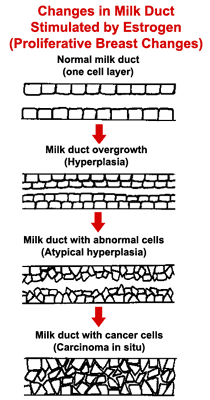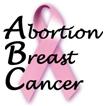Estrogen exposure
Exposure to Estrogen &
Breast Cancer Risk
Estrogen is a normal female hormone made in your ovaries and in your fat (adipose) tissue.
Estrogen is also recognized as a carcinogen in your body for certain types of cancer including breast cancer.
Estrogen stimulates your breast tissue to increase cell divisions (mitosis). This sometimes results in cancers due to errors in cell division (mutations). Other substances (carcinogens) or exposures (e.g., high dose radiation) can also result in cancer.
Below is an illustration of that effect:
The time it takes to go from one cancer cell to two, from two to four, four to eight, etc., is referred to as the doubling time. To go from one cancer cell to a group of cells about ½" inch in diameter takes approximately 8-10 years, if that cancer has an average doubling time. One-half inch is about the size at which a cancer can be found by physical examination. Mammograms can find tumors ¼" in diameter.
This is why, after being exposed to a risk factor; it may take 8-10 years before a cancer can be detected, even if the risk exposure has caused a cancer to develop.
Prolonged and increased estrogen exposure may cause your breast cells to progress from hyperplasia to atypical hyperplasia to cancer. Hyperplasia refers to the overgrowth of cells; for example, in multiple layers instead of one layer in a milk duct (see diagram).
Proliferative breast disease found on biopsy indicates an exposure to increased levels of estrogen. An increased risk of breast cancer is found in women who have proliferative breast disease.
Simply stated, the more estrogen your breasts are exposed to over your lifetime, the higher the risk of breast cancer.
During each monthly menstrual cycle, a woman is exposed to increased estrogen levels, especially at the time an egg is produced by her ovaries (ovulation).
Both early age at the start of menstrual cycles (menarche) and late menopause increase breast cancer risk through increased exposure to estrogen during menstrual cycles. Similarly, late age for menarche and early age for menopause decrease breast cancer risk. Birth control pills and hormone replacement therapy increase breast cancer risk through increased exposure to estrogen. Likewise, removing both ovaries before natural menopause decreases breast cancer risk by decreasing levels of estrogen. The more alcoholic beverages you drink, the more impaired your liver becomes in its ability to eliminate (metabolize) estrogen in your body. That is why regular alcohol consumption increases breast cancer risk in direct proportion to the amount of alcohol you drink.
After menopause, obesity increases breast cancer risk by increasing your level of estrogen. This is because fat tissue produces small amounts of estrogen. The more fat you have, the higher your estrogen level.
Before menopause, obesity causes hormonal changes which decrease estrogen production by the ovaries and can even result in infertility. Therefore, premenopausal obesity does not increase breast cancer risk.



